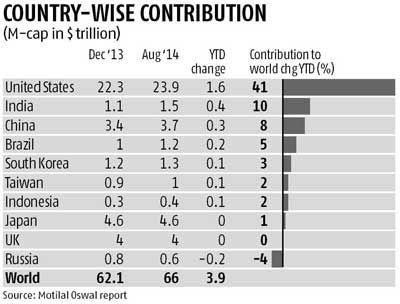 India is the second-highest contributor to the rise in global market capitalisation (market cap) this year, accounting for 10.25 per cent of the overall rise of 3.9 per cent, says a recent study by brokerage firm Motilal Oswal.
India is the second-highest contributor to the rise in global market capitalisation (market cap) this year, accounting for 10.25 per cent of the overall rise of 3.9 per cent, says a recent study by brokerage firm Motilal Oswal.
The US tops the list, accounting for 41 per cent of the rise in global market cap.
That country saw its market cap increase from $22.3 trillion in December 2013 to $23.9 trillion in August this year.
During the same period, India’s market cap rose from $1.1 trillion to $1.5 trillion, said the report, ‘Bulls & Bears-India Valuation Handbook’.
It added in the January-August period this year, global market cap rose to $66 trillion. With a contribution of $1.5 trillion, India’s contribution to global market cap stands at 2.3 per cent, above its long-term average of 2.1 per cent.
The run-up saw the Sensex outperform its emerging market peers, both in rupee and dollar terms. Currently, it is being traded at 17.4 times the FY15 earnings, a premium to all other emerging markets.
The valuation of Indian equities remains attractive, with a market cap-to-gross domestic product long-period average of 72 per cent, the report says.
The rally so far notwithstanding, analysts believe there is headroom for emerging markets.
“For equities, while we are still positive on developed markets, emerging markets appear to have more upside.Therefore, we favour emerging markets more.
Though these markets have uncertainties and geopolitical risks, these are stabilising and benefiting from a revival in developed markets. Asia, in particular, can expect a better performance, given the combined effect of a global recovery and structural reforms. For the broader emerging market universe, differentiation remains vital to identifying positive opportunities,” said a recent report by JPMorgan Asset Management.
In terms of regions, Goldman Sachs, in a recent report, maintained its overweight stance on China and Taiwan, while keeping an underweight rating on Malaysia, Hong Kong, Australia and Thailand, among other global markets. Most analysts say the next leg of the current rally in India will be driven by an improvement in corporate earnings.
“Through the past 15 years, returns of Indian equities have largely been driven by earnings growth. By contrast, this year has seen 27 per cent returns, of which 19 per cent is due to multiples expansion.
While this could be due to raised expectations on the back of a change in India's political leadership, we believe positive earnings momentum is required to sustain these returns,” Bhuvnesh Singh of Barclays Research said in an August 28 report, co-authored with Vijit Jain and Rachna Biyani. Saurabh Mukherjea, chief executive (institutional equities), Ambit Capital, says he sticks to the FY15 year-end target of 30,000 for the Sensex.
As investors gain faith in the ability of the Indian economy to grow at a reasonable rate, risk aversion related to India will fade, he says, adding there is more steam left in the rally here.








